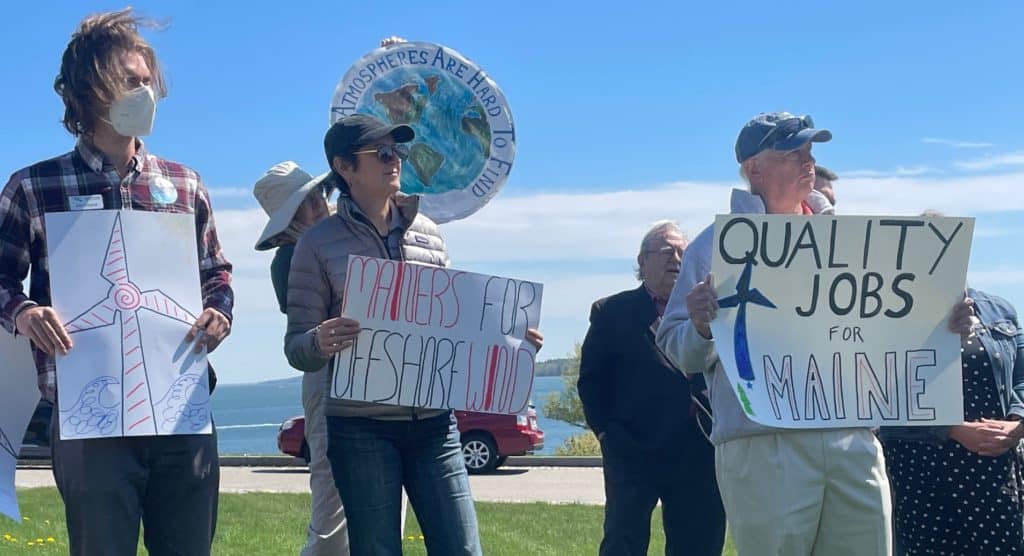
On May 18, 2022, Maine Audubon joined partners from the conservation, labor, and business communities for a press conference in Portland in support of offshore wind in the Gulf of Maine. The group gathered to urge state and federal governments to work quickly and responsibly in furthering locally-produced clean energy, just a day before the federal Bureau of Ocean Energy Management (BOEM) convenes a Gulf of Maine Intergovernmental Renewable Energy Task Force meeting to discuss offshore wind in the Gulf.
Maine Audubon Conservation Biologist Sarah Haggerty addressed the crowd to discuss the importance of offshore wind in meeting Maine’s climate goals, and how it must be responsibly sited and operated in order to minimize impacts to the environment. Also speaking in support of offshore wind were NRCM’s Climate & Clean Energy Program Director Jack Shapiro; Jason J. Shedlock, President of the Maine State Building & Construction Trades Council and member of the Laborers’ International Union; and President of the Maine State Chamber of Commerce Dana Connors.
Photos, remarks from Sarah Haggerty, and the press release can be found below.
Maine Audubon knows that the biggest and most pervasive threat to Maine’s wildlife and habitat is climate change. We are strong supporters of responsibly-sited renewable energy, including solar and wind, and work to better understand and advocate for strategies to avoid and minimize the impacts of development on Maine wildlife and habitat. Visit our Wind Power and Wildlife page for more information about Maine Audubon’s work to educate, advocate, and understand how offshore wind can benefit and coexist with wildlife in the Gulf of Maine.
News coverage:
WMTW: Maine coalition of environmentalists, unions, businesses backs offshore wind development
NewsCenter Maine: Maine leaders to meet with feds about future offshore wind projects
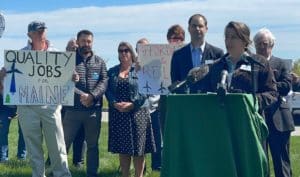
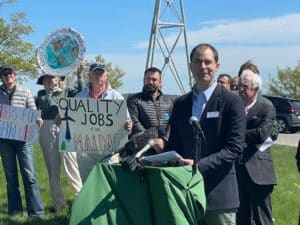
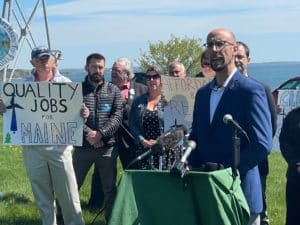
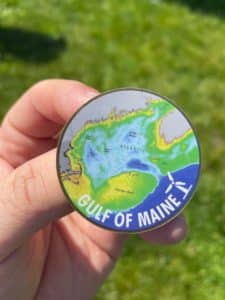
Remarks from Sarah Haggerty – May 18, 2022
Good morning. My name is Sarah Haggerty. I am a Conservation Biologist with Maine Audubon, Maine’s oldest and largest wildlife conservation organization.
For several years, I have focused my work on the intersection of renewable energy development and wildlife and wildlife habitat. Today, climate change is the single largest threat to Maine’s wildlife. Rapid deployment of renewable energy resources, including offshore wind, is critical to avoiding the worst impacts of climate change. But like any new development, if not responsibly sited and operated, offshore wind in the Gulf of Maine could put additional pressure on already vulnerable bird, bat, fish, and other marine wildlife populations.
As a result of my extensive study, I am confident that offshore wind can successfully coexist with wildlife in the Gulf of Maine. Though offshore wind in the U.S. is a relatively new industry, three decades of offshore wind development in Europe has shown that offshore wind power can be responsibility sited and operated if mitigation measures are implemented to protect local wildlife. These past successes, coupled with state- and U.S.-based data, research, and policy development, can be replicated here in the Gulf of Maine.
But it’s going to take a lot of work. Maine Audubon is committed to this work and we’re pleased to also see commitment from the State of Maine, the Bureau of Ocean Energy Management, and the partners we’ve joined today.
The Mills Administration has demonstrated their commitment to understanding how offshore wind can coexist with existing ocean users and wildlife in the Gulf of Maine by pursuing the development of an up to 12 turbine research array in federal waters about 30 miles off Maine’s coast. Information from this array will allow the State, the fishing industry, biologists like myself, and other stakeholders to learn about the potential impacts of floating offshore wind in the Gulf of Maine. This information will be used to responsibly site and operate the commercial offshore wind arrays that will be discussed at tomorrow’s Gulf of Maine Interagency Task Force Meeting, organized by the Bureau of Ocean Energy Management.
We strongly urge BOEM to grant the State its requested lease as soon as possible, just as we’ve urged BOEM to urgently fund gathering and assessing baseline ecological data in the Gulf of Maine. Understanding the location of important habitats and areas utilized by vulnerable species is critical to responsibly site offshore wind. Unfortunately, the Gulf of Maine is data poor. Federal, state, and other resources must be deployed as soon as possible to address these data gaps.
Maine has a unique opportunity to lead in developing well-sited and operated floating offshore wind with the least impact to wildlife and the environment. I am confident that we can get there. We must get there or a changing climate will cause the Gulf to be unrecognizable. This is only possible if BOEM, the State of Maine, and neighboring states fiercely pursue the development of a research array, and gather the critical data needed to inform responsibly sited and operated floating offshore wind.
Press Release:
Maine Audubon | Maine Conservation Voters | Natural Resources Council of Maine
MAINE-MADE OFFSHORE WIND WOULD POWER ECONOMY WITH CLEAN ENERGY
May 18, 2022 (Portland, ME) – Labor, business leaders, and conservationists today urged the state and federal governments to act quickly and responsibly to bring innovative, locally developed floating offshore wind technology to the Gulf of Maine.
“Maine has a unique opportunity to lead in developing well-sited and operated floating offshore wind with the least impact to wildlife and the environment,” said Sarah Haggerty, Conservation Biologist at Maine Audubon. “This is only possible if the state and federal governments fiercely pursue the development of a research array, and gather the critical data needed to inform responsibly sited and operated floating offshore wind.”
According to the National Renewable Energy Laboratory (NREL), offshore wind has the potential to be a major clean energy source for the electric grid that powers Maine and New England — and the winds in the Gulf of Maine peak in the winter months when Maine’s energy use is the highest.
The enormous amounts of renewable power generated by the wind turbines could help bring down wholesale electricity prices and provide a stable and affordable source of electricity to the state, cushioning Maine people and businesses from the price spikes they are experiencing from the region’s heavy reliance on fossil fuels.
“Offshore wind represents an enormous opportunity for Maine’s economic future. Developing this resource will create a new industry built here in Maine, by Maine people, for the benefit of our state,” said Maine State Chamber of Commerce President Dana Connors. “We can capitalize on this opportunity, but we must do so while ensuring the health of our marine resources including our lobstering and fishing industries.”
Innovative research from scientists and students at the University of Maine has positioned Maine to pioneer leading-edge floating wind turbine technology. Both the state’s ports and shipbuilding past position it well to develop a local clean energy industry that would generate good-paying jobs for Maine people.
“We know that building a clean energy economy and ensuring the safety and economic security of Maine’s working families are not — and must never be — mutually exclusive,” said Jason J. Shedlock, President of the Maine State Building & Construction Trades Council and a member of the Laborers’ International Union. “A thoughtful and responsible buildout of offshore wind also powers decades’ worth of family-sustaining careers with benefits for current and future members of Maine’s local unions, leading to projects completed safely, on time, and on budget that will be the homegrown pride of Maine.”
Developing offshore wind in the Gulf of Maine would help accelerate the region’s transition to clean energy, which will help meet Maine’s climate goals and greenhouse gas emissions reduction requirements. Projections show that wind projects deep offshore in the Gulf of Maine could not only serve the state’s electricity needs but also be exported to energy markets throughout New England to displace fossil fuel power plants.
“Adopting offshore wind as a significant energy source for Maine can help avert the worst impacts of climate change and make us more energy independent at the same time,” said Jack Shapiro, Climate & Clean Energy Director at the Natural Resources Council of Maine. “If responsibly built and operated, Maine’s home-grown floating wind turbine technology can deliver the large amounts of reliable, affordable clean energy we’ll need as we electrify our homes, businesses, and transportation.”
On May 19th, the Bureau of Ocean Energy Management (BOEM) will host the next Gulf of Maine Intergovernmental Renewable Energy Task Force meeting to discuss the process for wind energy leasing and the framework for stakeholder engagement. Supporters of offshore wind in New England recently called for the federal government to begin research projects that will both inform siting decisions moving forward and ensure multiple viewpoints are considered.
“Fighting the climate crisis is a shared responsibility, and we can do our part by responsibly harnessing the infinite power of the Gulf of Maine’s winds,” said William Sedlack, Program Manager at Maine Conservation Voters. “Offshore wind could create hundreds of good-paying, union jobs in our state and is a necessary component to meeting Maine’s goal of reaching 80% clean energy by 2030. Protecting both our climate and economic future by leading on floating offshore wind technology and manufacturing will help ensure that Maine isn’t left behind as the growing sector advances.”
The Governor’s Energy Office has also launched a Maine Offshore Wind Initiative and is developing an offshore wind roadmap to support the growth of this new industry
A single-turbine test project off Monhegan Island and a small-scale 12-turbine floating research array proposed for 30 miles offshore will allow University of Maine researchers to gather scientific data to better understand the performance of these unique floating platforms, how floating offshore wind in the Gulf of Maine interacts with the marine environment, and to support safe and sustainable development.
